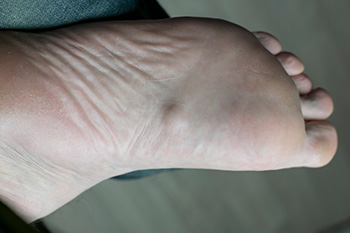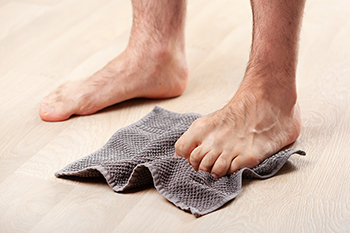Connect With Us
Blog
Items filtered by date: October 2025
What Is a Plantar Fibroma?

A plantar fibroma is a benign growth that develops in the plantar fascia, the thick band of tissue along the bottom of the foot. It appears as a firm lump that can cause pain or discomfort when walking or standing. The exact cause is unclear, but may involve genetic factors, foot trauma, or repetitive strain. Symptoms include tenderness, pressure pain, and stiffness in the arch. Relief may come from wearing supportive shoes, using orthotics, or applying gentle stretching and massage. A podiatrist can diagnose the condition, provide non-surgical treatments, and recommend advanced options, if needed. If you have developed a growth on the bottom of your foot, it is suggested that you consult a podiatrist who can offer effective relief and treatment solutions.
A plantar fibroma may disrupt your daily activities. If you have any concerns, contact Rahil Baxamusa, DPM of Illinois. Our doctor can provide the care you need to keep you pain-free and on your feet.
Plantar Fibroma
A plantar fibroma is a fibrous knot in the arch of the foot. It is embedded in the plantar fascia which is a band of tissue that extends from the heel to the toes along the bottom of the foot. There can be multiple plantar fibromas in the feet at the same time. There are no known causes for this condition. If you have a plantar fibroma, there will be a bump in the arch of your foot that cannot be missed. Any associated pain is most often due to a shoe rubbing against the nodule. Non-surgical options, such as steroid injections, physical therapy, and orthotics should be tried first. Surgery is a last resort and is the only thing that will remove a plantar fibroma entirely. Consult with a podiatrist for a proper diagnosis and to determine the treatment regimen that is right for you.
What Causes a Plantar Fibroma?
While there are no specific causes identified, a plantar fibroma can possibly come from genetic predisposition or the formation of scar tissue that forms from healing the tears in the plantar fascia.
What Are the Symptoms of a Plantar Fibroma?
There will be a noticeable lump in the arch of the foot that may or may not cause pain. If pain is felt, it is typically because a shoe is rubbing up against the lump or when walking or standing barefoot.
Treatment and Prevention
A plantar fibroma will not disappear without treatment, but it can get smaller and be a non-issue. If pain persists, a podiatrist examines the foot and when the arch of the foot is pressed, pain can be felt down to the toes. An MRI or biopsy might be performed to help diagnose or evaluate the plantar fibroma. The following non-surgical options are generally enough to reduce the size and pain of these nodules:
- Steroid injections
- Orthotics
- Physical therapy to help apply anti-inflammatory creams on the bump
Surgery is considered if the mass increases in size and the patient continues to feel pain after non-surgical methods are tried.
If you have any questions, please feel free to contact our office located in Crystal Lake, IL . We offer the newest diagnostic and treatment technologies for all your foot care needs.
Foot Exercises to Relieve Plantar Fasciitis Pain

Plantar fasciitis is inflammation of the thick band of tissue that supports the arch of the foot, often causing heel pain. Gentle stretching and strengthening exercises can reduce discomfort and promote healing. A calf stretch is done by standing facing a wall, placing one foot behind the other, and leaning forward to stretch the back calf. A calf stretch on a step involves lowering your heels off the edge of a step to lengthen the calf muscles. Additionally, the towel scrunch strengthens the arch by pulling a towel toward you with your toes, and marble pick-ups train foot control by lifting marbles with your toes. Plantar fasciitis can be painful, and may cause difficulty in completing daily tasks. If you have heel pain,, it is suggested that you consult a podiatrist who can diagnose the problem and offer you relief and treatment solutions, which may include targeted exercises.
Exercising your feet regularly with the proper foot wear is a great way to prevent injuries and build strength. If you have any concerns about your feet, contact Rahil Baxamusa, DPM from Illinois. Our doctor can provide the care you need to keep you pain-free and on your feet.
Exercise for Your Feet
Exercise for your feet can help you gain strength, mobility and flexibility in your feet. They say that strengthening your feet can be just as rewarding as strengthening another part of the body. Your feet are very important, and we often forget about them in our daily tasks. But it is because of our feet that are we able to get going and do what we need to. For those of us fortunate enough to not have any foot problems, it is an important gesture to take care of them to ensure good health in the long run.
Some foot health exercises can include ankle pumps, tip-toeing, toe rises, lifting off the floor doing reps and sets, and flexing the toes. It is best to speak with Our doctor to determine an appropriate regimen for your needs. Everyone’s needs and bodies are different, and the activities required to maintain strength in the feet vary from individual to individual.
Once you get into a routine of doing regular exercise, you may notice a difference in your feet and how strong they may become.
If you have any questions, please feel free to contact our office located in Crystal Lake, IL . We offer the newest diagnostic and treatment technologies for all your foot care needs.
Are Bunions Affecting Your Everyday Life?
Recovery After Bunion Surgery

Bunion surgery is performed to correct the bony bump that develops at the base of the big toe. After the procedure, it is normal to experience some swelling, soreness, and limited movement in the foot. Patients are often advised to wear a special shoe or boot to protect the area and keep weight off the toe as it heals. Elevating the foot and following the podiatrist’s instructions can make recovery smoother. Healing times vary depending on the type of surgery performed and the individual’s overall health, but many people return to normal activities within a few weeks to a few months. Targeted exercises may be recommended to restore strength and flexibility in the toe. With proper care and guidance, bunion surgery can relieve pain and improve mobility. If you are considering bunion surgery, it is suggested that you consult a podiatrist to discuss your options.
Foot surgery is sometimes necessary to treat a foot ailment. To learn more, contact Rahil Baxamusa, DPM of Illinois. Our doctor will assist you with all of your foot and ankle needs.
When Is Surgery Necessary?
Foot and ankle surgery is generally reserved for cases in which less invasive, conservative procedures have failed to alleviate the problem. Some of the cases in which surgery may be necessary include:
- Removing foot deformities like bunions and bone spurs
- Severe arthritis that has caused bone issues
- Cosmetic reconstruction
What Types of Surgery Are There?
The type of surgery you receive will depend on the nature of the problem you have. Some of the possible surgeries include:
- Bunionectomy for painful bunions
- Surgical fusion for realignment of bones
- Neuropathy decompression surgery to treat nerve damage
Benefits of Surgery
Although surgery is usually a last resort, it can provide more complete pain relief compared to non-surgical methods and may allow you to finally resume full activity.
Surgical techniques have also become increasingly sophisticated. Techniques like endoscopic surgery allow for smaller incisions and faster recovery times.
If you have any questions, please feel free to contact our office located in Crystal Lake, IL . We offer the newest diagnostic and treatment technologies for all your foot care needs.
Gout in Children and Adolescents

Hyperuricemia, or gout, is a condition caused by high levels of uric acid in the blood, leading to crystal deposits in joints. Although rare in children and adolescents, it can occur due to genetic factors, kidney issues, obesity, or certain medications. Risk factors include a family history of gout, poor diet, and metabolic disorders. Symptoms include sudden joint pain, redness, swelling, and warmth, often affecting the big toe. These painful flare ups can limit mobility and daily activities. A podiatrist can provide an accurate diagnosis, pain management, lifestyle recommendations, and supportive footwear to prevent recurring attacks. If your child or teenager has symptoms of gout, it is strongly suggested that you consult a podiatrist who can offer effective treatment and relief tips for this painful condition.
Gout is a painful condition that can be treated. If you are seeking treatment, contact Rahil Baxamusa, DPM from Illinois. Our doctor will treat your foot and ankle needs.
What Is Gout?
Gout is a form of arthritis that is characterized by sudden, severe attacks of pain, redness, and tenderness in the joints. The condition usually affects the joint at the base of the big toe. A gout attack can occur at any random time, such as the middle of the night while you are asleep.
Symptoms
- Intense Joint Pain - Usually around the large joint of your big toe, and it most severe within the first four to twelve hours
- Lingering Discomfort - Joint discomfort may last from a few days to a few weeks
- Inflammation and Redness -Affected joints may become swollen, tender, warm and red
- Limited Range of Motion - May experience a decrease in joint mobility
Risk Factors
- Genetics - If family members have gout, you’re more likely to have it
- Medications - Diuretic medications can raise uric acid levels
- Gender/Age - Gout is more common in men until the age of 60. It is believed that estrogen protects women until that point
- Diet - Eating red meat and shellfish increases your risk
- Alcohol - Having more than two alcoholic drinks per day increases your risk
- Obesity - Obese people are at a higher risk for gout
Prior to visiting your podiatrist to receive treatment for gout, there are a few things you should do beforehand. If you have gout you should write down your symptoms--including when they started and how often you experience them, important medical information you may have, and any questions you may have. Writing down these three things will help your podiatrist in assessing your specific situation so that he or she may provide the best route of treatment for you.
If you have any questions, please feel free to contact our office located in Crystal Lake, IL . We offer the newest diagnostic and treatment technologies for all your foot care needs.
Blog Archives
- November 2025
- October 2025
- September 2025
- August 2025
- July 2025
- June 2025
- May 2025
- April 2025
- March 2025
- February 2025
- January 2025
- December 2024
- November 2024
- October 2024
- September 2024
- August 2024
- July 2024
- June 2024
- May 2024
- April 2024
- March 2024
- February 2024
- January 2024
- December 2023
- November 2023
- October 2023
- September 2023
- August 2023
- July 2023
- June 2023
- May 2023
- April 2023
- March 2023
- February 2023
- January 2023
- December 2022
- November 2022
- October 2022
- September 2022
- August 2022
- July 2022
- June 2022
- May 2022

